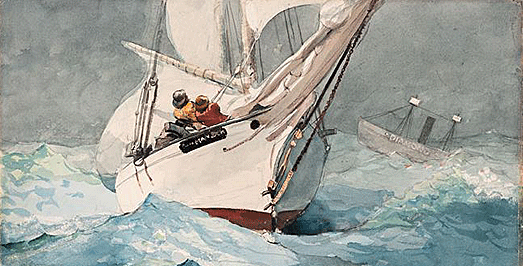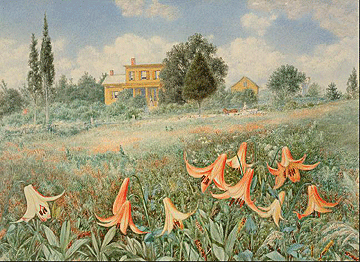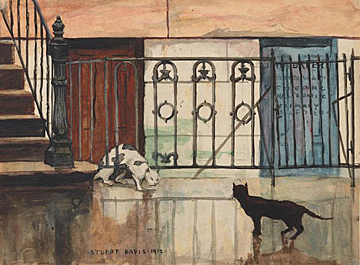Watercolor is a uniquely American medium. Two of the
artists credited with encouraging its use among serious artists were
Winslow Homer and John Singer Sargent. The watercolor movement tells a
story about innovation, experimentation, and the creation of bold new
ways of seeing the world. The Philadelphia Museum of Art has gathered
some rarely seen masterpieces which traces the rise of watercolor in the
United States for this exhibit.

Although widely practiced in the U.S. before the Civil War, watercolor
painting was mostly a medium for amateurs, women, and commercial
artists. The great fine art salons didn’t recognize it until much later.
Most professional artists saw it as a medium for preliminary sketches.
 Long
the domain of amateur painters, watercolors had finally gained
professional respectability in 1866 with the formation of the American
Water Color Society. Its annual exhibitions soon became the most liberal
forum in New York, uniting artists of all ages, styles, and backgrounds.
Drawing talent from the ranks of illustrators, who used watercolor on
the job, and gaining strength from the Impressionists and landscape
artists, who sketched in watercolor outdoors, the movement also welcomed
new arts and crafts designers.
Long
the domain of amateur painters, watercolors had finally gained
professional respectability in 1866 with the formation of the American
Water Color Society. Its annual exhibitions soon became the most liberal
forum in New York, uniting artists of all ages, styles, and backgrounds.
Drawing talent from the ranks of illustrators, who used watercolor on
the job, and gaining strength from the Impressionists and landscape
artists, who sketched in watercolor outdoors, the movement also welcomed
new arts and crafts designers.
The growing popularity of watercolor began to catch the eye of
collectors, who encouraged more artists to try the medium. By the early
1880s, every corner of the American art world was represented in the
Society’s galleries, from avant-garde painters returning from Europe to
established artists wanting to learn new techniques to illustrators
looking to elevate their work to fine art, and finally to women artists
seeking an entrée into the professional art world.
 The
American watercolor movement created stars like Winslow Homer, John La
Farge, Thomas Moran, and William Trost Richards, all of whom remained
dedicated to the medium for decades. Thomas Eakins, George Inness, and
others rode the wave through its peak in the 1880s. Together, their work
produced a taste for watercolor among younger artists and eager
collectors that would endure through the turn of the century. This
inspired a new illustrators, such as Maxfield Parrish and Jessie Willcox
Smith, decorators from the circle of Louis C. Tiffany, and plein air
masters such as John Singer Sargent, Childe Hassam, and Maurice
Prendergast.
The
American watercolor movement created stars like Winslow Homer, John La
Farge, Thomas Moran, and William Trost Richards, all of whom remained
dedicated to the medium for decades. Thomas Eakins, George Inness, and
others rode the wave through its peak in the 1880s. Together, their work
produced a taste for watercolor among younger artists and eager
collectors that would endure through the turn of the century. This
inspired a new illustrators, such as Maxfield Parrish and Jessie Willcox
Smith, decorators from the circle of Louis C. Tiffany, and plein air
masters such as John Singer Sargent, Childe Hassam, and Maurice
Prendergast.
But it was Homer who captured the imagination of the public through his
hauntingly beautiful scenes of the sea off the coast of Maine and the
forests of New York’s Adirondack Mountains. During the 1870s, Homer took
an interest in watercolor and plunged into using it. He eventually
worked extensively in watercolor, creating a fluid style while
chronicling his working vacations in the Adirondacks.
Homer recognized watercolor’s potential for profit—for he could produce
and sell these paintings quickly—but he also liked the way watercolor
allowed him to experiment more easily than oil. Their success enabled
him to give up his work as a freelance illustrator by 1875.
He created his first series of watercolor paintings in Gloucester,
Massachusetts, in 1873, and by the time he painted his last watercolor,
in 1905, he had become the unrivaled master of the medium in America.
From the beginning, his technique was natural, fluid and confident,
demonstrating his innate talent for a difficult medium.

Thanks to the legacy of Homer, Sargent, and their contemporaries, the
next generation—Charles Demuth and Edward Hopper among them—would choose
watercolor as a principal medium. Within 50 years, the Modernists would
demonstrate that the reputation of watercolor had been rebuilt as a
powerful and versatile “American” medium.
Through the landscapes and illustrations, as well as designs for stained
glass and ceramics, in this exhibit, viewers will experience one of the
country’s great artistic legacies.
